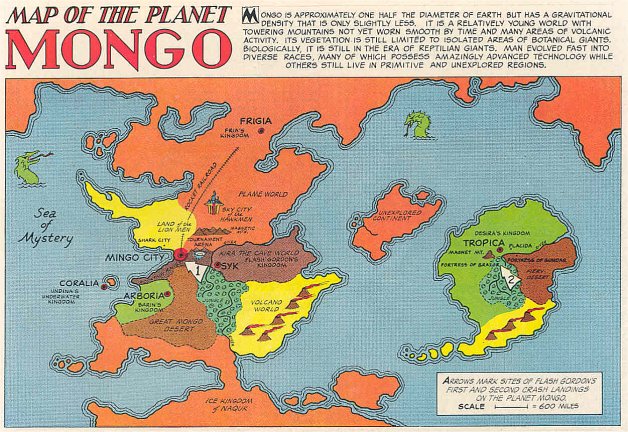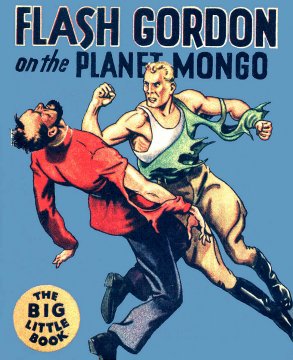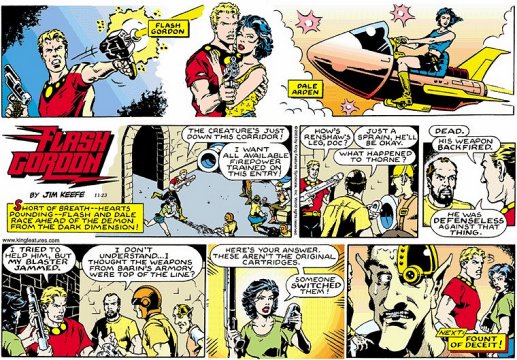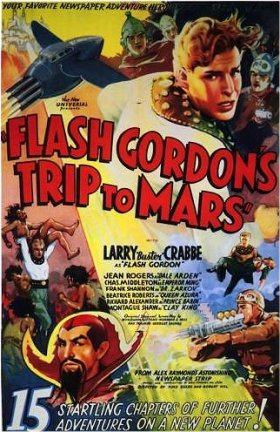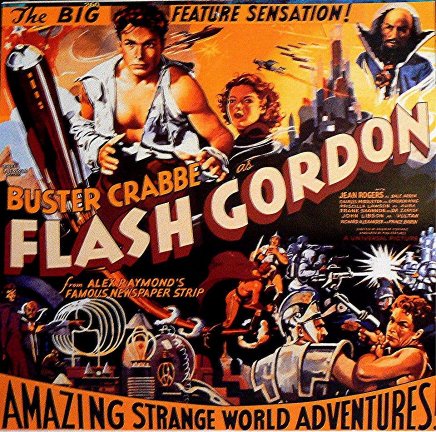FLASH
GORDON IN ALL HIS INCARNATIONS
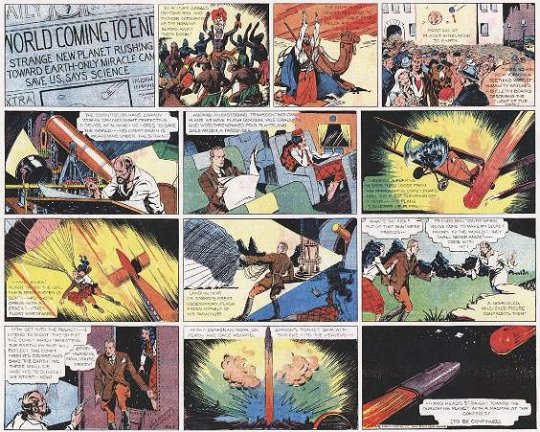
The first appearance of Alex Raymond's Flash Gordon,
in newspapers - January 7, 1934
Flash Gordon
began as one of the original newspaper serials. Not the first Newspaper
Serials, that honour would go to Tarzan
and Buck Rogers, which appeared on the same day in 1929. Flash
Gordon dates to January
7, 1934.
Created by Alex
Raymond, a noted serial artist, with assistance from an uncredited
pulp fiction writer named Don Moore, and inspired, at least in part by
King Features syndicate head Joe Connolly, Flash's roots can be traced
back to Jules Verne and Burroughs' John
Carter. The series was brilliantly successful, driven by
Alex Raymond's sumptuous artwork, and soon was far more popular than its
rival Buck Rogers.
Flash was incredibly successful. Alex Raymond's tenure on him
ran from 1934 to 1943, when the series was taken over by his assistant
Austin Briggs until 1948. Thereafter the strip has passed through
a variety of artists.
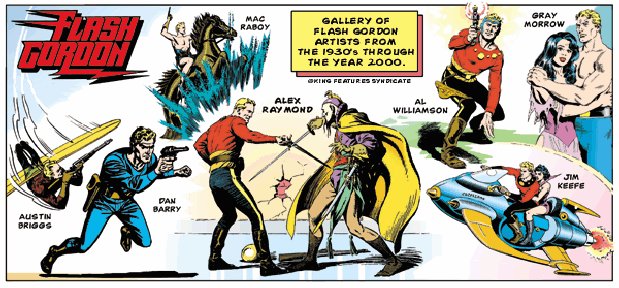
But along the way, Flash proliferated. First, there were a trilogy
of movie serials: Flash Gordon, Flash Gordon Goes
to Mars, and Flash Gordon Conquers the Universe, which in theme,
content and visuals followed the newspaper strips quite closely, between
1936 and 1940. There was also a Radio Serial in 1935 which
for most of its run held close to the newspaper serials continuity.
The 1980 De Laurentis film was also quite faithful to the visuals
and story of the Raymond serial, changing Flash from a Polo Player to a
Football Player, as was, astonishingly, the porno version Flesh Gordon
from 1973. The New Adventures of Flash Gordon, an animated
series from 1979 was also noted for its fidelity to the original Raymond
material. A subsequent animated series from 1980 was
also faithful, though it moved Flash up to a war correspondent in Warsaw.
Some adaptations weren’t nearly so faithful. There was a 1954
live action Flash Gordon TV series, shot in Germany and set in 3200,
where Flash Gordon was an interstellar traveller. Flash Gordon
appeared as part of a super team in Defenders of the Earth.
He showed up as a skateboarding teenager in the 1996 animated series, and
as a dimension traveling young university student in the 2007 live action
series. In a series of pocket novels from the 1973s, Flash
Gordon was a deep space explorer, and in the 1980's another series of novels
left little resemblance. A very belated Flesh Gordon sequel
had very little to do with anything. And of course, there are the
comic books.
The bottom line is that Flash Gordon is a pretty mutable property, some
versions being completely unrecognizeable, dispensing with or modifying
the supporting cast, sometimes abandoning Ming and Mongo. Sometimes
Flash goes to other dimensions, or rather than Mongo, goes deeper into
space to Ganymede, or into interstellar space. Sometimes he's a teenager,
sometimes a slacker. Through roughly 70 years and translations into
just about every media and forum, there's been a lot of liberties taken.
But past all that, there's a very solid consistent core that makes Flash
Gordon, and this is the Alex Raymond series, particularly the first few
years, that established the seminal story, which gets retold in the movie
serials, the radio version, the De Laurentis and the porno movie.
Thanks to Bill Hillman, I've had a chance to go through some of the
collections of those early serials. In some ways, they're pretty
tough slogging. As a newspaper serial, they have to have some sort
of climax or plot twist or dramatic moment every three or four panels,
or at most, on the colour Sunday supplement, a page or a half page.
Flash may have been the master of outer space, but physical space was his
nemesis. Read daily in isolation, they're okay, even rivetting.
Read them all at once, and something very like fatigue closes in.
Too many plot twists, too many climaxes, too many twists and turns, every
few panels, and beyond that too much repetition. It's the same problem
with the old movie serials, except amped up to the max.
Nevertheless, the strengths and weaknesses are on display. At
times, there’s sloppiness and archaisms, the Arborians dress like they
missed a Robin Hood casting call. Ming's generals look and dress
like late 19th century Prussians, complete with buttons and epaulets.
Squirrels, horses and tigers appear, renamed sqirlons and tigrons, or gussied
up with a cheap forehead horn.
On the other hand: There's a beauty to the artwork, a lusciousness.
Someone once said that Raymond drew nude figures under their clothes, and
that comes across. The plot proceeds on a breakneck pace, the cast
of characters all but jumping in and out of bed or in and out of combat
with each other. Some monsters are unique and fascinating.
THE
ESSENTIAL FLASH GORDON
The core is this: It;s the 1930s (with some variation),
the world is under siege by cosmic calamity, usually meteor bombardment,
but sometimes storms, rays, funky weather, volcanoes, you name it.
Scientists have spotted a new planet in the Solar System, Mongo, on a collision
course with Earth.
Flash Gordon and his girlfriend Dale Arden are just two young people,
caught up in all this madness. Somehow, they encounter a crazy old
recluse, something of a mad scientist, Hans Zarkov, who abducts or enlists
them on a space trip to Mongo, the source of all Earth's current woes.
On Mongo, they're taken prisoner by the tyrannical ruler of the planet,
Ming the Merciless, who is taken with lust for Dale Arden. Meanwhile,
Ming's daughter, Princess Aura, has the hots for Flash, which upsets her
suitor, Prince Barin. Hans Zarkov gets put to work by Ming, but somehow,
our intrepid heroes escape and encounter strange races and people, including
Hawk-Men, Shark-Men and Lion-Men. Eventually, Flash precipitates
the overthrow of Ming's empire.
I think one of the reasons for the success of Flash is that in many
ways, it comes very close to being archetypal. Flash is not a rocket
scientist, he's not even a pilot, he's basically a young athlete, a kind
of everyman hero. Dale is the classic good girl. Princess Aura
is the classic bad girl, Ming the classic villain. Even Dr. Zarkov
is an achetypical character -- he's the classic mad scientist, with the
remarkable swerve of being thrown onto the good guys side (but many portrayals
of him, such as the 1973 porno version, or the De Laurentis version, even
the serial, preserve a fundamental ambiguity). Even supporting
characters have a distilled essential quality - the Lion Man, Prince Thun,
or the suitor, Prince Barin are archetypal figures in their own right.
And its not just archetypal, but once these characters are set in motion,
the plot drives them in wild directions, the story doesn't let up.
But I'd argue that one of Flash Gordon's most interesting and overlooked
characters is the Planet Mongo itself, the home of Ming, the earth-threatening
world, the land of strange contrasts, exotic races, and even more exotic
lands.
It’s Alex Raymond’s Mongo that I’d like to examine, using Raymond’s
map. It’s likely that Mongo started off as a pretty blank place -
just a scary planet on a collision course, and Ming’s throne room.
But over time, the map gets filled in, and after a few years of Flash’s
adventures, there was enough of Mongo to make a map, and enough of a map
for me to run some analsysis.
So here goes....
SIZE
AND COMPOSITION
As Venus is the twin of Earth, Mongo seems to be the twin of Mars.
Mongo may well have been an analogue Mars. The description
suggests:
“Mongo is approximately one half the
diameter of Earth, but it has a gravitational density that is only slightly
less. It is a relatively young world with towering mountains not
yet worn smooth by time and many areas of volcanic activity. It’s
vegetation is still limited to isolated areas of botanical giants.
Biologically, it is still in the area of reptilian giants. Man evolved
fast into diverse races, many of which possess amazingly advanced technology
while others still live in primitive and unexplored regions.”
This gives us our starting point. The diameter of the Earth
is roughly 7926.4 miles. Approximately one half of that would
be roughly 3913 miles, give or take say 10%, which gives us a range of
size between 3521 or 4314 miles diameter. This makes Mongo
around the size of Mercury (3031 miles diameter), at its smallest, or in
the vicinity of Mars (4200 miles diameter) at its largest.
The reference to "gravitational density" helps us to define Mongo further.
Mongo's gravity is depicted as less than Earth's but the difference is
not substantial. In the Flash Gordon series, Mars is depicted as
having substantially less gravity than either Earth or Mongo.
So we know that Mongo’s gravity, while significantly less than Earth is
still substantially more than Mars.
* Earth's gravity is defined as 1.0, and its density is 5.5.
* Mars gravity is .37 of Earth, and its density is 3.4.
* Mercury's gravity, despite its smaller size, is almost identical
to Mars at .38, but its density is almost equal to Earth’s at 5.43.
The gravity of a world is a factor of its size and its density. Thus,
Mercury, with only 3/4 of Mars diameter and only 40% of its volume, has
a slightly greater gravity because it is 65% more dense.
But Mercury is 70% metallic and 30% silicate. It's almost entirely
a ball of iron wrapped around a rocky shell. Earth's density is a
factor of its vastly greater size and the gravitational compression that
comes about. Without gravitational compression, Earth's density would
only be about 4.4, as compared to Mercury’s 5.3.
Mars' low gravity is despite its greater volume, a factor of its low
density. If Mars low density of 3.4 were closer to Mercury’s 5.4,
then its gravity would be at least 50% or more greater, perhaps around
.56 to .65.
Understanding this gives us an idea of how big or small Mongo can be.
If Mongo was towards Mercury in size, even with a near Earth density, it’s
gravity could be no more than a few points above Mercury’s own .38, perhaps
.42 or .43. Mongo must be closer to Mars in size, perhaps
4000 to 4300 miles diameter, with a density of around 5 or better, for
a gravity about 2/3rds that of Earth. Or perhaps a density of 4 or
4.5 for a gravity of about half earths.
Mongo's density suggests that its composition is far more like that
of Mercury than of Mars. A world of 60 to 70% metallic core and a
30 to 40% silica exterior. The heavy metal core suggests that
Mongo may, like Earth, have a differentiated inner and outer core, and
that it likely has a strong magnetic field. Mongo exhibits
continuing volcanism and mountain formation, implying a still hot molten
core and possibly something like plate tectonics.
LOCATION
AND ORBIT
The next question becomes 'Where is Mongo?' Here, it gets a little
tricky. In the original Flash Gordon universe of the newspaper,
radio and movie serials, Mongo is a planet in our solar system, although
for some reason, it's an overlooked planet.
Of course, that's a little crazy, astronomers tend not to miss stuff
like that, so later editions and versions fudged the issue, or simply threw
Mongo out with the bathwater. The 1952 newspaper serial put Flash
on Ganymede. The 1950s television series and the 70s novels had Flash
well beyond the solar system into deep space. The De Laurentis movie
had Ming as an interstellar tyrant, knocking off worlds left and right.
The most recent television series put it in another dimension.
But if we go with the original source materials, Mongo is definitely
in the solar system. Hell, for a while it looked like it was on a
collision course with Earth, and an accompanying cloud of meteors were
bombarding the hell out of Earth.
So, somehow, the astronomers must have missed it. Later, we’ll
look at how and why.
But if it is in the Solar System, where can Mongo be? Well there
are only a few possibilities. First, we have to acknowledge that
it is not the only planet in the inner solar system. There's also
Earth, Venus, Mars and Mercury. Presumably, wherever it is,
it has to be in an orbit that would prevent it from interfering with the
orbits of any of these other worlds. If it comes too close, its gravity
would perturb the orbits of other worlds. If it crosses their
orbits, inevitably, there would have been a collision billions of years
ago. So Mongo has to be in a stable circular orbit in relation
to the other worlds.
Mongo sports a habitable biosphere with oceans, polar caps and a live
hydrological cycle. There's no indication that its environment is
artificially maintained or created. It seems to be relatively easily
accessible from both Mars and Earth, at least some of the time.
The conclusion is that Mongo must be located somewhere in the 'habitable
zone' for Earth-like planets -- ie, the area occupied by Mars, Venus
and Earth.
In the Flash Gordon newspaper strips, Mongo is bombarding Earth with
meteors. This might imply a location nearer the asteroid belt,
where there is a ready supply of such rocks, perhaps in the vicinity of
the orbit of Mars, or even beyond Mars. But beyond Mars is too cold.
In the original Flash Gordon serial, Mongo is on a collision course with
Earth, which might imply a very erratic orbit. In the second movie
serial, Ming gets involved with Mars, suggesting that Mongo has at least
as much proximity to Mars as to Earth.
Where can that orbit be? Well, if we look at the other worlds,
it seems that they can only come so close to each other. Venus and
Mercury at their closest possible approach come only within 23.5 million
miles. Venus and Earth come at their closest with 26 million miles.
Venus and Earth are the largest bodies in the inner solar system, so we
can assume that 23 to 26 million miles is probably a good rule of thumb
for safe distance. Less than that, say below 22 million you’re probably
risking trouble.
Can we squeeze Mongo between Mars and Earth? The distance between
Earth and Mars at their closest approaches range from 36, but can be as
much as 64 million miles. That's kind of problematic.
If Mercury to Venus is our rule, we need about 47 million miles space between
Earth and Mars to squeeze Mongo in. We only have that sometime.
At the closest approaches, we are 11 million miles short. That's
tricky.
But Mars is a much smaller body than Earth or Venus, so perhaps a smaller
world like Mongo would be able to come closer to a small world like Mars
without disturbing their orbits too much. Both planets are only a
fraction of the size of Earth or Venus.
Unfortunately, we don’t have any real-life examples in the solar system
to work with, so it's guesswork. However, as a rule of thumb, let's
guess that the closest approach distance would be roughly 2/3rds that between
Mercury and Venus or slightly less, or roughly 14 or 15 million miles.
This would give us a figure of 39 to 36 million miles as between Mars,
Mongo and Earth. That's just about there.
So, based on this, we can take a reasonable guess at Mongo's orbit.
Earth's farthest distance from the sun is about 94 million miles, and Mars'
closest
is 128 million miles. Mongo's maximum outer orbit can take
it no closer than 14 million miles from Mars, and 22 million miles from
earth. It's about 114 to 116 million miles in a nearly perfectly
circular orbit. Mongo's orbit is therefore much more like Earth's
and Venus', rather than more eccentric places like Mars and Mercury, whose
distances from the sun within their own orbits can vary about 20 million
miles. It's variance may be less than two million miles.
Of course, there'll be perturbations of some sort. By the 19th
and early 20th century, measurements were getting very precise, and we
were working out the masses and orbits of the planets, as well as their
effects on each other. But for now, let's fudge it a bit and assume
that a Solar System with Mongo in it, in our hypothetical orbit wouldn't
be too wildly out of whack. This is just guesswork of course, I've not
got the physics background to calculate just how close you could get a
world like Mongo to Earth or Mars without dramatically screwing up their
orbits.
Are there other possibilities for Mongo's location? A couple.
We could place Mongo outside the orbit of Mars. But that's tricky.
Mars' outer orbit is 154 million miles out. If we assume that Mongo's
orbit is somewhere between 14 and 26 million miles beyond that, we've got
a distance of 168 to 180 million miles out. That puts it very
close to or right on the edges of the Asteroid belt. That gives us
a problem, that close to the Asteroid belt, Mongo should be a cratered
pincushion. And at that distance, Mongo should be significantly colder
than Mars, perhaps uninhabitably cold, and obviously its not. So
Mongo can't exist outside the orbit of Mars.
Is there anything that might pitch us this way? A couple of things.
First, erosional processes might have erased many of Mongo's craters, leaving
it less of a moonscape. We can assume most of its asteroid and meteor
hits would have been in the distant past, although it probably gets regular
spectacular meteor displays. While it should be a cold dim
world, an extreme greenhouse effect and perhaps internal heating might
make it a warmer world. So we can't quite rule it out.
The other possibility is that Mongo might have a very eccentric orbit.
It might be off the plane of the ecliptic (the 'plane' that most of the
other planets orbit along -- essentially, most of the planets and satellites
in the solar system circle around as if on a record player, not up, not
down, just flat), like Pluto, with much fewer close approaches.
Mongo might well be at right angles or some other steep angle, leaving
it to cross the plane of the ecliptic only twice in its year, and only
for a few days or weeks at a time. Given that Earth, Mongo
and Mars all have different lengths of revolution, it would probably mean
that close approaches would only come once every few thousands of years.
This explains both the Flash Gordon serial where Mongo appears headed
towards Earth. Normally, when all worlds are on the same plane,
a close approach might be every few years. With Mongo off the ecliptic,
a close approach would only be every few millenia if that.
It might also help to explain why Mongo hasn't been noticed by Earth's
scientists. It's only occasionally in the plane of the ecliptic,
and in the vicinity of observation.
However, even if Mongo was off the plane of the ecliptic, it would still
be circumscribed by the need not to approach the other worlds too closely.
So this still puts Mongo in either the 114 to 116 million mile, our orbit
doesn’t change.
The chief advantage of the non-ecliptic orbit is that it would suggest
that Mongo’s approaches to Earth are fairly rare, on the matter of centuries
or millennia or more, this may be significant given Mongo's technological
advantage over earth.
THE
HIDDEN WORLD
Ancient societies, including the Sumerians, the Greeks, Egyptians, Chinese
and the Mayans had correctly managed to identify and plot the orbits of
the other planets out as far as Saturn. Mars, Venus, Mercury
and Jupiter were all well identified. Mongo, which was the
size of Mars, should have been hard to miss. Particularly a
Mongo in an orbit between Earth and Mars should have been at least half
again or twice the brightness of Mars.
It's possible that Mongo was in a trans-Martian orbit. A Mars
sized object significantly further out might well have been overlooked.
But this seems unlikely. Mars was a bright star.
Mongo, at even half or a third the brightness of Mars should still have
been spotted.
Even a Mongo off the ecliptic in either orbit should have been spotted.
It would not have been in the same plane as other worlds, but it would
still have been visible in the night sky, and might have attracted even
more attention.
So why wasn't Mongo well known to ancient astronomers? It
seems to have been unknown, even to modern astronomers until comparatively
recent times.
The best explanation is that Mongo is for some reason, an extremely
dark body. By this we mean that it is far less reflective of sunlight
than other solar system bodies. This is not necessarily out
of the question. Earth’s and Mars brightness changes with the expansion
and orientation of their polar caps. On Earth, the larger the polar
caps and glaciers, the more light is reflected away and the colder it gets.
Upper atmosphere dust from volcanoes also reflects more light and therefore
reduces the temperature on Earth significantly.
Perhaps a quality of Mongo’s atmosphere simply absorbs far more light,
resulting in a darker and less reflective world. This might make
Mongo a much warmer world than Mars, despite being nearly as far
from the sun. Mongo might also be sitting in the center of
a dust cloud, obscuring or scattering its reflected light and reducing
its visibility.
Even so, astronomers would have been guessing or looking for Mongo during
the 19th century. This was the century in which the Asteroids were
being discovered, when Uranus and Neptune were discovered.
It was an era where orbital perturbations which could not be explained
under Newtonian physics left astronomers searching for planets beyond the
orbits of Saturn and inside the orbits of Mercury.
So, no matter how dim Mongo would have seemed, by the 19th century,
physicists would have likely detected Mongo through orbital perturbations
in Mars. Mind you, they may have decided to look in the wrong
place, calculating, according to Bode's law, a planet or planetoid in the
asteroid region.
Even so, sooner or later Mongo, no matter how dim, would have been spotted.
Astronomers were detecting Ceres, Pallas and Vesta in far orbits and only
a fraction of the size of regular planets. Even a Mongo reflecting
a mere fifth or tenth of the light of Mars would have been detectable by
telescopes.
And this was during a period when Astronomers were detecting and searching
for all sorts of hypothetical planets. Through the 19th century there
were multiple controversial sightings of a planet inside the orbit of Mercury
called Vulcan. There were also sightings of a possible moon
of Venus that they called Neith. There was a speculated second moon
of Earth, as well as additional satellites of Jupiter, Saturn and Uranus.
In the context of these searches, Mongo might well have been detected during
the 19th century.
But astronomers might well have simply reclassified it as just another
asteroid. By the late 19th century, hundreds of asteroids had been
identified and dismissed as small chunks of rocks. Rather than being
planets as first thought, they were being dismissed as 'rats of the sky'
of interest only to the pedantic. Mongo as a very dim body
might have been considered as little more than a rogue asteroid or cluster
of asteroids of no particular significance. It's gravitational effects
might have been attributed to Mars, causing mis-calculations of that bodies
mass.
It would have only been during the 1930's and the advent of radio telescopes
and Einsteinian physics that Mongo would have been identified as a substantial
world in its own right. By that time, it was too late. Ming
was already making his force felt.
GEOLOGICAL
HISTORY OF MONGO
A look at the Map allows us to assess the state of the physical exterior
of Mongo. As a Mars sized world, Mongo's surface area is approximately
50 million square miles, or roughly equivalent to the combined land area
of Earth.
Mongo seems to feature three major Mountain/Volcanic chains, each of
which seem to run Northeast/Southwest near the equator. The
placement of these chains seems to suggest that we are not looking at the
conventional mountain/volcano building of moving tectonic plates, as seen
in the Pacific Ring of Fire.
Rather, it appears that what we may have is a moving 'hot spot' similar
to that which produced the Hawaian Islands, except on a vastly larger scale.
Indeed, the geography of Mongo seems best interpreted as the result of
a vast, 45% arc of uplift which moved in stages from north to south before
eventually proceeding east.
The best theory is that Mongo's outer crust is too thick and undifferentiated
to allow for Earthlike plate tectonics. Instead, the core's interior
heat is dispersed through an uplift region similar to Mars Tharsis region,
which represents an area of instability between the core and mantle, which
has drifted over the ages.
Geologically, this means that the oldest areas of Mongo are the north,
and the youngest area is the Tropicana continent.
It also suggests that Mongo is more like Mars and Venus than Earth --
no plate tectonics, and a much thicker crust. Taking a leaf from
Venus, I'll go out on a limb and suggest that like Venus, Mongo's thick
crust and moving 'hot spot' uplift means that Mongo's elevations are pretty
narrow. Mongo, like Venus, doesn't have the same highs and lows of
Earth or Mars. Earth's highs and lows are essentially light tectonic
plates floating over and against heavier ocean plates on a sort of semi-fluid
magma. Mars' highs and lows are probably the result of gigantic asteroid
impacts in its southern hemisphere, and mostly that its 'tectonic hot spot'
is not mobile but stationary -- so Mars 'highest' lands, the Tharsis bulge
just kept getting higher and higher. But unlike Mars, Mongo's
hot spot is moving slowly, so it doesn't reach the same elevation.
Instead of piling up higher and higher, Mongo's hot spot keeps moving,
building new
land. Result -- shallow seas, relatively flat land
masses.
Significantly, two of Mongo's mountain ranges are notable for their
hypermagnetic properties. There are the Magnetic Mountains of the
main continent, near the equator, and the Magnetic Mountain of Tropicana.
These appear to be the magnetic poles for the planet, which means that
the molten inner core appears to be rotating on an axis perpendicular to
the planet’s north/south axis of rotation. It appears that
the drift of the inner core's axis has been principally responsible for
the formation of the continental masses.
It is not clear why the inner core began to drift out of alignment to
the planetary axis of rotation. We know that Earth's magnetic poles
have drifted and even reversed, but have no clear idea of the mechanism
or reason for this. However, Earth is a much larger world with a
much thicker mantle. It seems that on Mongo, whatever the reason
for the drift, the shift of the axis of the molten inner core affects the
outer core, which in turn creates a stress area between the outer core
and mantle resulting in an uplift region.
But it seems that the process has been slow and progressive over much
of the planet's history. It appears that only one pole has primarily
produced uplift, so the most likely reason is that once an uplift region
forms the weight or distortion pushes the out of balance core axis away
and the drift continues. It seems notable that uplift
formation changed direction after uplift formation at the south pole, moving
north and east, rather than continuing in its broad north/south direction.
This suggests that a the force of a large body impact in the south hemisphere,
just off the south pole, created a shockwave on the other side of the planet,
similar to the Elysium and Tharsis regions of Mars or the disordered territory
of Mercury. There's probably a very big archaic crater in Mongo's
ocean. One that we can't see, because it's covered by Mongo's ocean.
There might, however, be a circle of ringing seamounts or island archipelagos.
Unlike Mars or Mercury, however, Mongo possessed a differentiated core
and a molten inner core whose axis of rotation was set adrift.
OCEAN
CURRENTS OF MONGO
Mongo possesses extensive ocean regions covering perhaps 2/3rds of its
surface. Essentially, almost all of Mongo's land is a continuous mass consisting
of polar regions and a connecting equatorial band, with two small Island
continents and a handful of large islands. Mongo's land area is somewhere
around 10 to 20 million square miles. Discounting uninhabitable
glaciated polar regions, Mongo's habitable lands are likely 8 to 15 million
square miles, or roughly the size of Earth's American continents.
So, what's the weather like on Mongo? Well, we can make some assessments
from the shape of the land. Mongo almost certainly doesn't
have polar caps, or at least not the same sort of polar caps that we do
on Earth or Mars. Earth's Antarctic ice cap is the result of
a land mass at the Earth's pole, much like the land masses at Mongo's pole.
However, Earth's Antarctic ice cap is a recent development, resulting
from the Antarctic circumpolar current. Essentially, this is an ocean
current which travels around and around Antarctica in a circle. Because
of it, warm water and warm air don't circulate in to warm the continent.
The effect is a deep freeze, keeping the cold in and the warmth out.
Up until roughtly 25 million years ago, there was no circumpolar
current. Instead, Antarctica was closely enough connected to South
America, Australia and Kerguelen that instead of circling, water was forced
north and south. Thus frigid antarctic waters circulated up the sides
of continents, condensing clouds and bringing rain, while warm equatorial
waters circulated south into the polar region warming it. In the
northern hemisphere the European gulf stream warms Europe and Scandinavia,
giving the region its temperate climate.
On Mongo, while glaciers may form at both poles, there’s a constant
circulation of equatorial waters north and south which moderates the polar
climate. It’s likely still cold and unpleasant, but ice caps are
probably much smaller, if present, than on Earth.
Indeed, Ocean currents probably govern much of the climate of Mongo.
We can identify a north current which begins in equatorial waters off of
the region known as flame world. It moves north, moving warm waters
up to the polar region where, and then turns into a southern cold current
moving arctic waters south down the western border of the Tropican continent.
This circular current revolves around the 'Unexplored' continent.
A comparable Arctic current begins in the southern polar kingdom of 'Naquk',
and proceeds east, delivering Arctic waters north to the 'Tropican' continent.
From there, it turns and brings tropical waters down the coasts of 'Volcano
World.'
These Arctic currents, moving in opposite directions, deliver cold waters
to the eastern shores of Tropican, lowering the equatorial temperature
here. The result, however, are constant inland rains, as moisture
continually condenses from cold air. The result is the western side
of the Tropican continent is the most well-watered region of Mongo.
The Polar Regions of Frigia and Naquk particularly in these areas benefit
from temperate climates, although the climates are generally dryer.
These regions are well watered, but their water derives mainly from glacial
melt flow.
Meanwhile, on the western side of the central continent, an immense
south polar gulf opening onto the Sea of Mystery creates a reservoir of
cold water. This becomes the source of cold currents which travel
north up the western shore of the continent, creating a cool rain forest
climate in Arboria. The current continues to move up to the
land of the Lion Men, where the outthrust peninsula directs the arctic
current into the open equatorial sea, leading to fierce and unpredictable
storms.
Meanwhile, the northern section of the Sea of Mystery, with its numerous
bays, is probably the most moderate sea. The shoreline is too far
from the extreme arctic to allow strong currents to form. The region
is cool and generally dry, featuring moderating currents.
GEOGRAPHY
OF MONGO
In the northern region, is the land of Frigia, cold and semi-arid.
Eastern Frigia features a relatively moderate/northern European climate
with extensive rivers draining into the sea from glaciers. Western
Frigia tends to be colder and more arid, because it is not warmed by strong
tropical currents. Geologically, Frigia is the oldest region of Mongo,
and so its mountain and valley features have shown the most wear.
Frigia is a land of rolling hills and highlands.
Southeast of Frigia is an arid semi-desert but warm or temperate region
known as 'Flame World.' The region is known for massive basaltic
rock, with savage cliffs and chasms. It appears that volcanism has
resumed after a long geological period of inactivity, but at a decidedly
lower level. It represents a relative highland.
Southwest of Frigia are the temperate grasslands of the Lion Men.
This region features open rolling plains and low weathered mountains.
Its geography is remarkably flat, the weather temperate and rainfall extends
through the year. Its peninsular geography at temperate latitudes
means that its climate is relatively benign.
Almost directly south is mountain range running from the coast to the
centre of continent. These mountains are some of the highest and
most ferocious, blocking ocean rains from reaching the interior of the
continent. The portion of the mountain ranges in the centre are known
as the Magnetic mountains, and appear to be the current location of the
magnetic south pole. The mountain range also tends to divide northern
and southern hemisphere climactic regions.
South along the western coast is the temperate rain forest region of
Arboria, watered by rains from the ocean currents. The region borders
on the Great Mongo desert located in the interior. The abrupt distinction
between Arboria and the Desert suggests that the desert is a highland region
and so inaccessible to low hanging rain clouds, while its elevation and
slope drains away any internal rainfall which reaches the area.
Quixotically, beyond the desert is a region of thick tropical jungle
or rain forest. Beyond the jungle is a geologically active highland
region called ‘Volcano World’. The jungle region drains by
rivers both north and south, and may have once represented a trapped sea.
It's clearly a lowland region and environmental sink.
North of the jungle and facing out onto the eastern coast is the region
known as 'Syk' or 'Kira the Cave World' or Flash Gordon's Kingdom.
With a moderate European or New England climate, the region is geographically
hilly and mountainous, dotted with numerous valleys. It features
a complex drainage into the jungle area.
To the south, connected by an Isthmus is the ice kingdom of Naquk, which
is presumably partially glaciated.
Beyond this, there are two island continents, the smaller of which is
largely unexplored, but is known for year round stormy weather.
The island continent of Tropica is about two thirds subtropical grassland
and rain forest, with a large central tropical rain forest/jungle.
Mountain ranges bisect the centre of the continent, with the other side
being desert and volcanoes.
Mongo is characterized by complex disordered geography over shifts of
latitude with extreme changes in elevation, rainfall, rock composition,
age, temperature, climate and fertility over short distances. The
result is a series of sharply defined microclimates and discrete ecological
and environmental zones.
SECRET
ORIGINS OF A MYSTERY WORLD
All of the worlds or the Inner solar system originated from the same
primordial cloud of dust. So by rights, their composition should
have been fundamentally similar. In the beginning, this was
true. A handful of bodies in size between Mars and Venus formed and
went through similar histories. They accreted from clouds of dust,
growing in mass as their growing gravity cleared their orbital pathways,
vacuuming up billions of meteors and asteroids. As they grew,
the heavier elements sank towards the center forming metallic cores of
iron and radioactive elements. Heated by friction, compression and
decaying radioactives, molten cores formed in the center, surrounded by
heated rocky mantles and cold inert crusts. The lightest elements,
carbon, oxygen, nitrogen, even hydrogen and helium formed atmospheric envelopes.
Four billion years ago, these proto worlds were all twins to each other.
But there were too many, their orbits crossed and criss crossed with
each other, and with surviving proto-planet bodies, latecomers.
Mercury, a Mars-sized body, was struck by an object perhaps half the size
of Earth's moon. The impact tore its outer shell away, leaving
only the molten core intact. Mercury regained some of its rocky exterior,
but only a fraction, leaving it a smaller, heavier, metallic world.
Mars also had ferocious collisions at Argyre and Hellas, impacts which
nearly cracked the planet open and which shaped its geography.
Perhaps the most astounding impact was Earth itself, which collided with
a Mars sized planet. In the resulting impact, the core of the Mars-sized
world vanished into the shattered Earth, which absorbed much of the debris.
The cloud of dust and debris beyond Earth eventually coalesced into the
Moon, making it the youngest of the inner worlds.
Mongo, between Earth and Mars had a similarly cataclysmic history.
Originally, Mongo was a world between Mars and Venus in size. Then
it had a catastrophic impact as with Mercury, an impact which shattered
much of its outer shell and left it like Mercury, a reduced, extremely
heavy body.
Like the new Earth, Mongo was left with a volatile active core and a
vast orbiting dust cloud. Unlike Earth, Mongo's dust cloud did not
coalesce into a satellite like the moon, or into an elaborite ring system
like Saturn. Instead, two or more competing satellites formed
over a hundred thousand miles beyond Mongo. One of these satellites
raced in a conventional orbit on the plane of Mongo's ecliptic, the other
had a highly eccentric orbit, tilted over 45 degrees from Mongo's orbital
plane. Tidal effects from this satellite might be in part responsible
for Mongo's moving hot spot, which is also tilting at about 45 degrees.
The interaction of these satellites kept the dust cloud from settling,
their near approaches to each other continually stripping their accumulated
dust covers.
As a result, Mongo lay wrapped in a hot blanket of planetary dust and
debris which blocked a fraction of the light coming in, and much of the
light being reflected away. This left Mongo a dark and invisible
world to the naked eye. Despite its size and proximity to Earth,
it was by far the dimmest of the near worlds, being less bright even at
closest approaches, than a small asteroid. Seen only occasionally,
it was often mistaken for a comet or asteroid.
The surface of Mongo is dimmer, the conditions not quite twilight.
The sun is an indistinct body, the sky, even the twilight and evening sky
unaccountably bright with refracted sunlight.
LIFE
ON MONGO
Due to its perpetual dust shroud, Mongo's surface actually receives
at best slightly more, or perhaps even less light than Mars. On the
other hand, due to scatter, Mongo's twilight and night side receives far
more refracted light. The polar regions of Mongo also receive disproportionately
more light. Mongo is a dim world, with few shadows and little more
than a bright area in the sky to signify the sun, but true night is brief.
Mongo's reduced light means that the surface energy for photosynthesis
is roughly equivalent to that in Earth's northern temperate or subarctic
region. Plant growth, while profuse, is relatively slower than in
comparable latitudes on Earth.
Most of Mongo's biological activity takes place in its Oceans and Seas
which make extensive use of photosynthesis and nutrient rich seas.
Mongo possesses a single continuous world Ocean of some 35 million square
miles, a body comparable to the Atlantic on Earth. With its tributary
bays and seas, the Ocean is Mongo's largest and richest biozone.
For the most part, Mongo's seas are warm and shallow with strong currents
between polar and equatorial regions.
The sea floor is occupied by gigantic tentacled monsters and crustaceans,
while fish-like animals swim in profusion. Given that there
are people calling themselves Shark-men, we can assume that there are sharks,
or equvalent on Mongo. A notable large shallow bank similar to the
Grand Banks off Newfoundland is the home of the Maritime nation known as
the Shark Men whose semi-submerged cities dot the region. Overall,
it is likely that Mongo's oceans are not nearly as deep as the Earth's.
Earth's oceans are kilometers deep. Mongo's may only be a couple
of hundred meters, if that. And the Shark Men's part of the ocean
may only be dozens of meters.
By comparison the land area of Mongo is, except for a few jungle and
rain forest regions, generally spartan and sterile. Extensive volcanism
has created rich landscapes, but high metal content makes many regions
semi-sterile. Naked rock in vast quantities occurs everywhere on
Mongo. In the movie serials, Mongo is a very barren planet
with large expanses of rock and boulders. But even a desert world
has oases, and Mongo's shores and rivers have plenty of water, so life
does exist in profusion in some areas.
Due to the low light, plants tend to thick broad leaves. Grasses
have never really emerged on Mongo. The dominant plant species are
characterized by deep root systems, thick branching stems and large dark
leaves. Often plants will sport multiple colours or shades to maximize
photosynthesis. Land animals on Mongo include giant reptilians, large
anthropoids and mammalian predators.
There seem to be three major lines of animal life on the land areas
of Mongo:
1) Transplanted Earth Animals -- Tigers, big cats, squirrels,
horses, elephants, etc., all recogniseably kin to their terrestrial counterparts,
but with enough changes and alterations to suggest either that they've
been on Mongo long enough to adapt into new species, or perhaps artificially
altered. One consistent peculiarity of Mongo life is that most animals
are horned, even where their terrestrial counterparts are not -- including
apes, elephants and tigers. The presence of recognizeably terrestrial
lineages on Mongo suggests that there has been contact, perhaps recurring
contact, between Mongo and Earth in the distant past. But if any
Mongo life ever got transplanted to Earth, it now seems to be long extinct.
Actually, based on Raymond's drawings of indigenous Mongo life, one
could make an argument that at least one species of Mongo life made it
to Earth and survived for a time....
2) Dragons -- not actual dragons per se, but there aren't a lot
of better words for them. Pseudo-dinosaurs perhaps. Unlike
theropod dinosaurs who tended to be bipeds, or at least to have back legs
much longer and heavier than front legs, these animals tend to have mammal-like
proportions, long tails, long flexible necks, slim builds and differentiated
teeth. They're clearly vertebrate tetrapods, so they may well be
related to some more primeval earth life. But except for the Shirrush,
there isn't anything in folklore or the fossil record which particularly
resembles them.
The Shirrush, an animal depicted in Babylonian statuary, but unknown
to science, conforms closely to Raymond's depictions of Mongo’s animals,
and may well have been a transplanted species.
3) Worms -- Mongo has one form of life with no real earthly equivalent.
These creatures variously resemble terrestrial cephalopods, starfish and
worms, but they're not quite any of these. Essentially, they appear
to be invertebrates, but invertebrates with some sort of pseudo-skeletal
structure inside. They're bilaterally symmetrical and wormlike or
serpent-like in form, but instead of limbs, they sport tentacles growing
from their sides. These tentacles may have eyes or sensors at the
end. They're stronger and more maneuverable than a cephalopod's tentacles,
but overall, the beasts appear lower energy than the other two, their metabolisms
run more slowly. Nevertheless, perhaps because of this, some of them
may grow huge. Some specimens dwarf the blue whales of earth.
Giant underwater specimens may resemble octopuses.
HUMANITY
ON MONGO
Oddly enough, Mongo lacks true alien species. There is nothing
like the Tharks, the Formians, the Lunar Ga-Vas, etc. Rather,
Mongo is populated by humans and in some cases by what are clearly human
variants, subspecies. To confuse things further, some of the
peoples of Mongo may be humans of variant cultures, but not true subspecies.
For instance, the Lion-Men of Mongo definitely appear to be a human
subspecies, diverged from the main line. On the other hand,
are the Shark-Men of the Sea a true human subspecies, or simply a divergent
culture? Are the Hawk Men with their wings a true human subspecies,
or are they merely a tribe which uses artificial wings to fly?
Some observations come to mind. First, Mongo as a whole
is thinly populated, and the population distribution is very uneven.
As Flash Gordon travels, he finds large areas of Mongo empty of human life,
even in many fertile areas, humans are rare or absent. This
suggests that Mongo’s human populations tend to be isolated from each other
for long periods.
Another key factor is that Mongo, compared to Mars or Venus is very
diverse. Most of Venus is tropical jungles and islands. Most
of Mars is water poor desert and oasis. So both of these worlds tend
to have uniform populations (within reason - Mars has icy polar regions,
and lost marshland and wet regions which host unique species of animal
and intelligent/human life. While Venus has cool polar regions which
appear to have unique populations -- but for both worlds over 80% of the
planets are uniform). So it's likely that Mongo's geographical
and climactic diversity have led to very different cultures and very different
human races.
Oddly, the diversity of 'races' and lifestyles of Mongo's humans are
not echoed by the certain cultural features. Most or all of the human
races on Mongo seem to speak a common language, and common styles of clothing
and governance predominate. Among many of the civilized nations
of Mongo a uniform level of technological accomplishment seems to exist,
with local variation or adaptation in places like Frigea or the seas of
the Shark People.
The implication is that Mongo has had long periods of planetary government
where a single empire has been able to enforce and spread its language,
technology and culture across the world. On the other hand, it appears
that the different regions of Mongo prize their independence highly. And
it may be difficult for an Empire to maintain its control over a long span.
It's likely that Mongo's history is a long one of on again/off again empires
punctuated by periods of squabbling but isolated states. Ming's
dominion may only be the latest in a long line of them.


